InterviewSolution
Saved Bookmarks
This section includes InterviewSolutions, each offering curated multiple-choice questions to sharpen your knowledge and support exam preparation. Choose a topic below to get started.
| 18051. |
Question : Describe the structure of sex chromosomes. |
Answer» SOLUTION :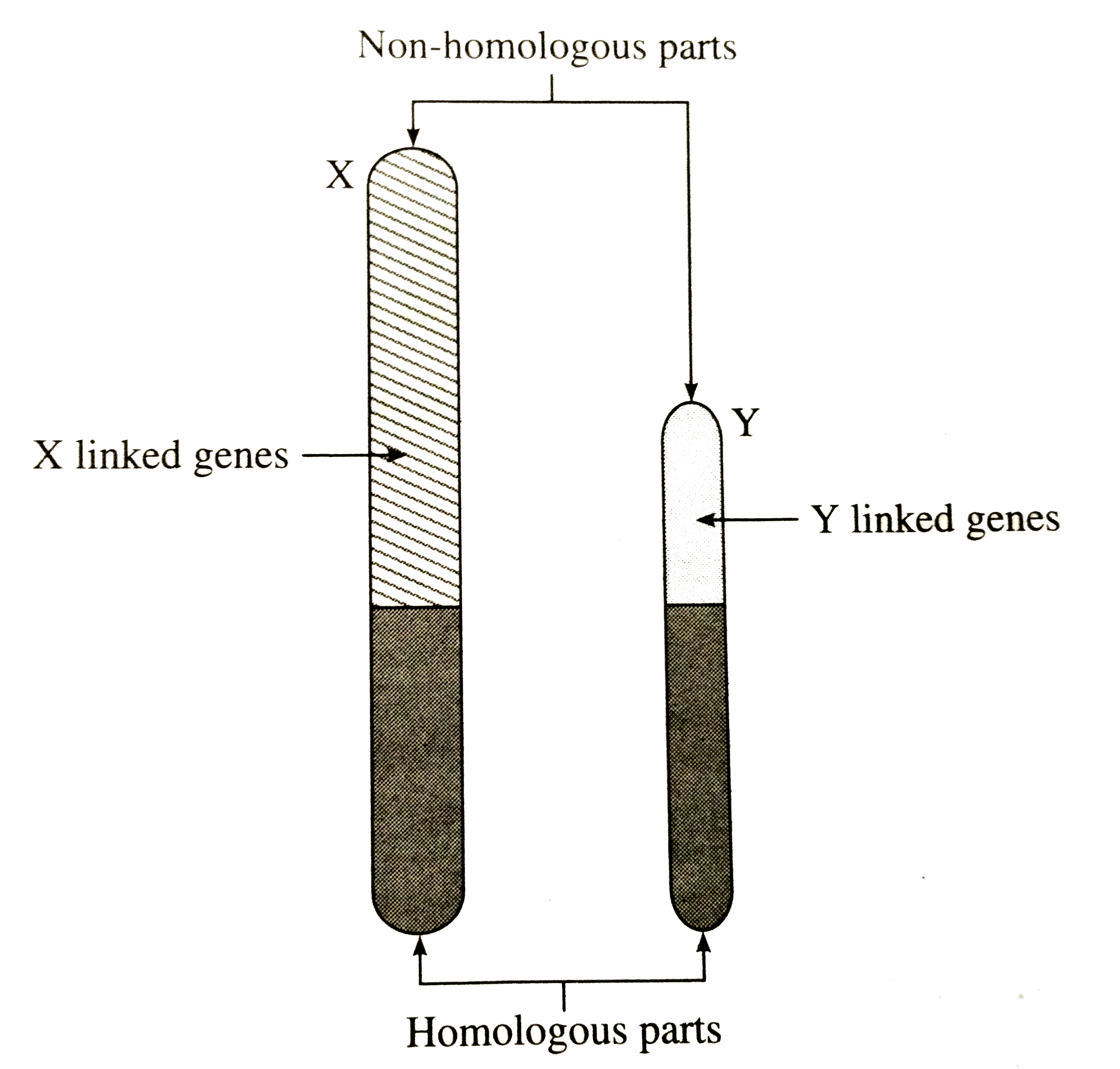 (1) X-chromosome is longer, sub-metacentric chromosome with large amount of euchromation and smaller amount of heterochromatin. (2) Y-chromosome is shorter, ACROCENTRIC with small amount of euchromatin and large amount of heterochromatin. (3) X-chromosome has more GENES and DNA, while Y-chromosome is genetically less active chromosome. (4) Non-homologous REGIONS of X- and Y-chromosomes contain X-linked and Y-linked genes respectively. |
|
| 18052. |
Question : Describe the structure of pollen grain and explain the development of male gametophyte in it |
|
Answer» Solution :The POLLEN grains represent the male GAMETOPHYTES that is located in microspores. By TOUCHING the opened anthers of Hibiscus or any other flower, deposition of yellowish powdery pollen grains are found on fingers. Sprinkling these grains on a drop of water taken on a glass slide and observing under a microscopes, variety of architecture sizes, shapes, colours, designs are seen on the pollen grains from different species. Structure of Pollen grains: Pollen grains are generally spherical measuring about 25-50 micrometers in diameter. It has a promient two layered WALL. The hard outer layer called the exine is made up of sporopollenim which is one of the most resistant organic material  It can withstand high temperatures and strong acids and alkali. No enzyme that degrades sporopollenin is so far known.  Pollen grain exine has prominent apertures called germ proes. Where sporopollenn is absent. Pollen grains are well preserved as fossils because of the presence of sporopollenin. The inner wall of the pollen grain is called the intine. It is a thin and continuous layer made up of cellulose and pectin. Thedevelopment of male gametophyte in pollen grain. The cytoplasm of pollen grain is surrounded by a plasma membrane. When the pollen grain is mature it contains two cells, the vegetative cell and generative cell. The vegetative cell is bigger, has abundant food reserve and a large irregularly shaped nucleus. The generative cell is small and floats in the cytoplasm of the vegetative cell. It is spindle shaped with dense cytoplasm and a nucleus. In over 60 percent of angiosperms, pollen grains are shed at this 2-celled stage. In the remaining species, the generative cell divides mitotically to give rise to the two male gametes before pollen grains are shed (3-celled). Pollen grains of many species cause severe ALLERGIES and bronchial affictions in some people often leading to chronic respiratory disorders-asthma bronchitis etc. Note: It may be mentioned that Parthenium of carrot grass that came into India as contaminant with imported wheat, has become ubiquitous in occurrence and causes pollen allergy. |
|
| 18053. |
Question : Explain the structure of pollen grains in Angiosperms. |
|
Answer» Solution :Structure of pollen grain: Pollen GRAINS represent the male gametophyte and they also called "botanical fingerprints".  1. The pollen grain has surrounded by prominent two layered wall. 2. The hard outer thick layer called exine and which is made up of sporopollenin, which is one of the most resistant organic materials. It can withstand against high temperatures and strong acids and alkali. 3. No ENZYME degrades sporopollenin. 4. The exine has prominent apertures called germ pores where sporopollenin is absent. 5. The inner thin wall of the pollen grain called intine made up of cellulose and pectin. 6. The cytoplasm of pollen grain surrounded by plasma membrane. 7. When the pollen grain MATURES, it consists of two cells, the vegetative cell and generative cell. 8. The vegetative cell is larger in size with large amount of reserve food material and a large irregularly shaped nucleus. 9. The generative cell is smaller in size and floats inside the cytoplasm of vegetative cell. 10. It is spindle shaped with dense cytoplasm and a nucleus. 11. Internally each pollen grain posses two types of nucleus called generative nucleus and tube nucleus. 12. The generative nucleus divides and forms two male gametes and tube nucleus develops pollen tube after pollination. |
|
| 18054. |
Question : Describe the structure of Megasporangium with a diagram |
Answer» Solution :The ovule is a small structure attaced to the placenta by means of a STALK called funicle. The body of the ovule fuses with funicle in the region called hilum. Thus hilum represents the junction between ovule and funicle. Each ovule has one or two protective envelopes called integuments. integuments encircle the nucellus EXCEPT at the tip where a small opening called the micropyle is organised. opposite the micropylar end, is the chalaza representing the basal part of the ovule. Enclosed within the integruments is a mass of cells called the nucellus. Cells of the nucellus have abundant reserve food materials. Located in the nucellus is the EMBRYO sac or female gametopyte. An ovule generally has a single embryo sac formed from a megaspore.  Megasporogenesi: The process of FORMATION of megaspores from the megaspore mother cell is called megasporogenesis. Ovules generally differentiate a single Megaspore Mother Cell (MMC) in the micropylar region of the nucellus. It is a large cell containing dense cytoplasm and a prominant nucleus  The MMC undergoes meiotic division. Meiosis results in the production of four megaspores. The development of female gametophyte: In a majority of flowering PLANTS, one of the megaspores is functional while the other three degenerate. Only the functional megaspore develops into the female gametophyte. This method of embryo sac formation from a single megaspore is termed as monosporic development |
|
| 18055. |
Question : Explain the structure of megasporangium. |
Answer» Solution :The angiosperm ovule is called Megasporangium. It is attached to the placenta by funcile and the body of the ovule fuses with funicle at Hilum. It has one or TWO protective ENVELOPES called integuments. Integuments posses a small opening at the tip called micropyle. Opposite to micropylar end, is the chalaza, REPRESENTING base of the megasporangium.  Enclosed within the integuments is a mass of cells with abundant food reserve materials called the nucellus. Located in the nucellus is the EMBRYO sac or FEMALE gametophyte. |
|
| 18056. |
Question : Describe the structure of lymph node with a labelled diagram. |
Answer» Solution :Lymph node has three zones .They are the cortex ,paracortex and medulla.The outer most layer of the lymph node is called cortex,which is RICHLY populated by T lymphocytes and interdigitating dendritic cells .The inner most ZONE is called the medulla which is sparsely populated by lymphocytes,but many of them are plasma cells,Which actively secrete antibody molecules.As the lymph enters,it slowly percolates through the cortex,paracortex and medulla,giving sufficient chance for the phagocytic cells and dendritic cells to TRAP the antigen brought by the lymph.The lymph leaving a node carries ENRICHED antibodies secreted by the medullary plasma cells against the antigens tht ENTER the lymph node.Sometimes visible swelling of lymph nodes occurs due to active immune response and increased concentration of lymphocytes.Thus swollen lymph nodes may signal an infection There are several groups of lymph nodes.The most frequently enlarged lymph nodes are found in the neck ,under the chin,in the armoits and in the groin. 
|
|
| 18057. |
Question : (a) Describe the structure of human spermatozoa with a labelled diagram. |
| Answer» SOLUTION :The human sperm is a microscopic, flagellated and motile gamete. The whole body of the sperm is enveloped by plasma . The HEAD comprises of two parts namely acrosome and nucleus. Acrosome is a small cap like pointed structure present at the tip of the nucleus and is formed mainly from proteolytic enzyme , popularly known as sperm lysin which helps to penetrate the ovem during fertilization . The nucleus is FLAT and oval . The neck is very short and is present between the head and the middle PIECE. It containsthe proximal centriole towards the nucleus which plays a role in the first divisiion of the zygote and the distal centriole gives rise to the axial filament of the sperm. The middle piece possesses mitochondria spirally twisted around the axial filament called mitochondrial spiral or nebenkern. It produces energy in the form of ATP molecules for the movement of sperms. The tail is the longest part of the sperm and is slender and tapering. It is formed of a central axial filament or axoneme and an outer protoplasmic sheath. The lashing movements of the tail push the sperm forward. | |
| 18058. |
Question : Describe the structure of human excertory system with suitable diagram. Add a note on the process of urine formation. |
|
Answer» Solution :For diagram, Human excretory system consists of the following organs, VIZ. a pair of kidneys, a pair of ureters, a single unpaired urinary bladder,urethra in males or vestibule in FEMALES. 1. Kidney: (1) The kidneys are dark red, bean-shaped organs about 10 cm long, 5 cm WIDE and 4 cm thick. (2) Each kidney is convex on lateral margin. There is a notch called hilus present on the medial surface. Blood vessels, nerves and ureters enter and leave the kidney through hilus. They are concerned with excretion and osmoregulation. 2. Ureters :Ureters are a pair of narrow ducts about 40 cm long, each coming out of kidney through the hilus and opening in urinary bladder. They carry urine from the kidneys to urinary bladder by peristaltic contractions. 3. Urinary Bladder: Urinary bladder is a single pear-shaped structure with thick muscular wall that is lined by transitional epithelium and a thick layer of detrusor muscle. It stores 500 ML to 1 litre urine temporarily. Urine is expelled out at intervals through urethra. 4. Urethra : Urinary bladder opens into urethra. The urethral opening is guarded by urethral sphincter which is under voluntary control. Urination or micturition is the PROCESS of emptying the urinary bladder. |
|
| 18059. |
Question : Draw and label the structure of a human ovum. |
|
Answer» Solution :• Ovaries are the primary female sex organ PRODUCING eggs (ovum). • They are located one on each side of lower abdomen (pelvis). • The ovary is attached in pelvic wall uterus by an ovarian ligament called mesovarium. • It is an elliptical structure of 2-4 cm long • Each ovary is covered by thin cuboidal germinal epithelium encloses ovarian stroma. • Below germinal epithelium is a DENSE connective tissue called tunica albuginea. `*` The stroma is differentiated into outer cortex and inner medulla. • The cortex is dense and GRANULAR due to follicular cells at varying development stages. • The medulla is a loose connective tissue with BLOOD vessels, lymph vessels and nerve fibres. |
|
| 18060. |
Question : Describe the structure of chromosome with a suitable diagram. |
|
Answer» Solution :Structure: Metaphasic chromosome lias two sister chromatids which are identical halves. (a) Each CHROMATID in turn is made up of subchromatids called chromonemata. 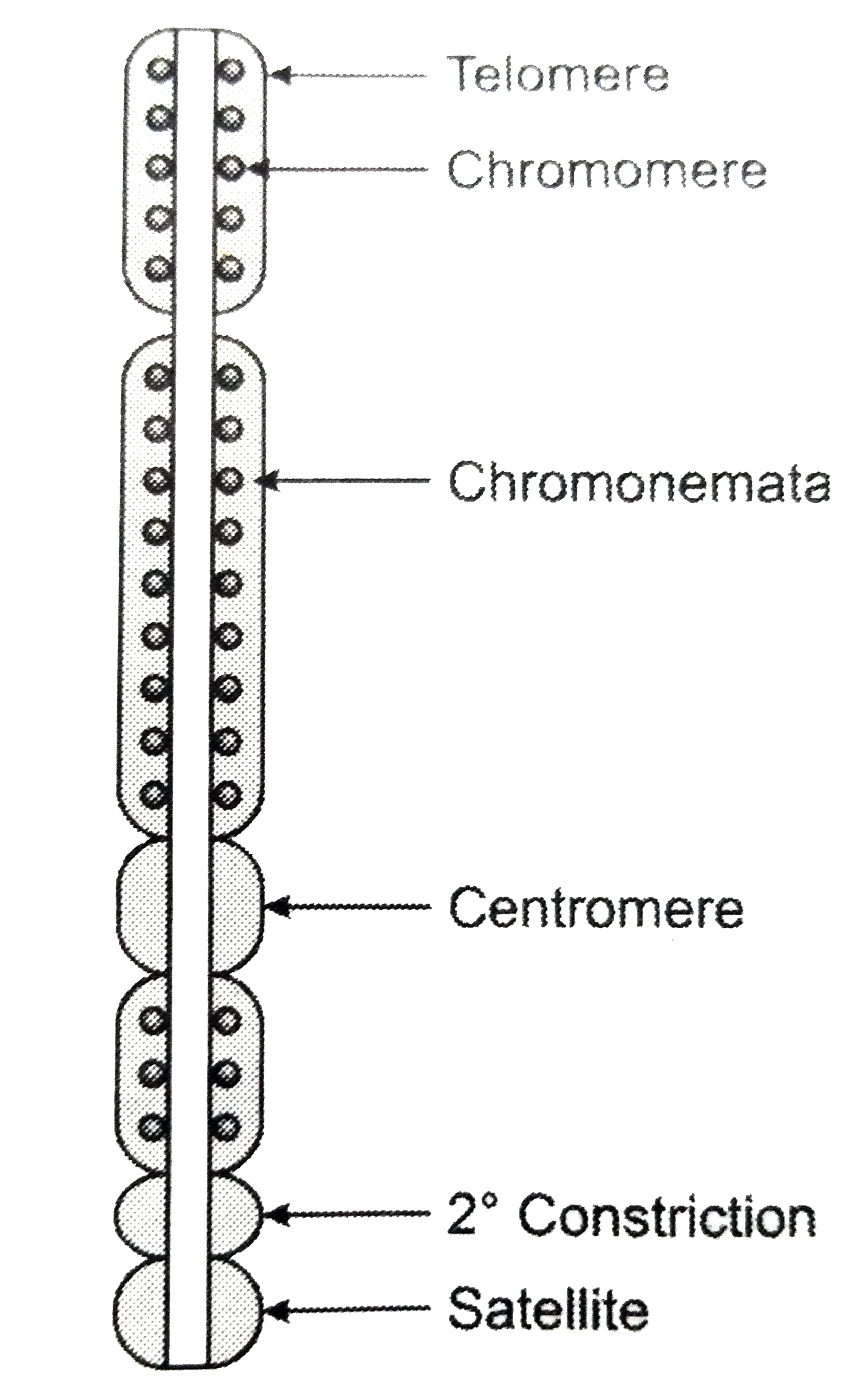 (b) Chromatids are held together at one point called centromere. It is also called primary constriction. (c) Additional narrow areas called `2^(@)`-constrictions are present. (d) Some of the `2^(@)`-constrictions are called nucleolar ORGANIZER because they are necessary for formation of nucleolus. (e) Short spherical structure beyond nucleolar organizer is called SATELLITE. (F) Tip of chromosomes is called telomere. It prevents STICKING of chromosomes ends. (g) Surface of chromosome bears number of small smellings called chromomeres. |
|
| 18061. |
Question : Describe the structure of HIV with a diagram. |
Answer» SOLUTION :The human IMMUNODEFICIENCY virus belongs to the genus Lentivirus When observed under the electron microscope ,HiV is seen as spherical virus,100-120 nm in diameter,containing a dense core surrounded by a lipoprotien envelope.The envelope has glycoprotien (gp)spikes termed gp 41 and gp 120 .At the core ,there are two large single stranded RNA .Attached to the RNA are molecules of reverse transcriptase.It also contains enzymes LIKE PROTEASE and ribonuclease.The core is covered by a capsid made of protiens.This is followed by another layer of matrix protiens as SHOWN above. 
|
|
| 18062. |
Question : Describe the structure of chromosomes with a suitable diagram. |
|
Answer» Solution :1. STRUCTURE of chromosomes : (1) A chromosome during metaphase shows two identical halves. These halves are called sister chromatids. (2) Each chromajid is made up of sub-chromatids called chromonemata (singular-chromonema). (3) The chromatids are HELD together by a centromere or the primary constriction. During cell division the spindle fibres are attached at the centromere. ADDITIONAL narrow areas called secondary constrictions are SEEN in some chromosomes which are known as nucleolar organizers. They help in the formation of nucleolus.  (4) The part of the chromosome beyond the nucleolar organizer is called satellite which is short and spherical. (5) The tip of the chromoson1e is called telomere which HELPS in preventing the ends of the chromosomes from sticking together. They attach the chromosomes to the nuclear envelope. (6) The surface of a chromosome bears a number of small swellings called chromomeres. |
|
| 18063. |
Question : Describe the structure of cerebrum add a note on its functions. |
|
Answer» Solution :1. Structureof cerebrum : (1) Cerebrum is the largest part of the brain. It FORMS 80-85 % of the brain. (2) A median longitudinal fissure dividesthe cerebruminto twocerebral HEMISPHERES. These hemispheresare interspheres are interconnected by athick band of transversenervefibrescalledcorpuscallosum. (3) The outerpart ofcerebrumis called cortex while theinner part is called medulla. 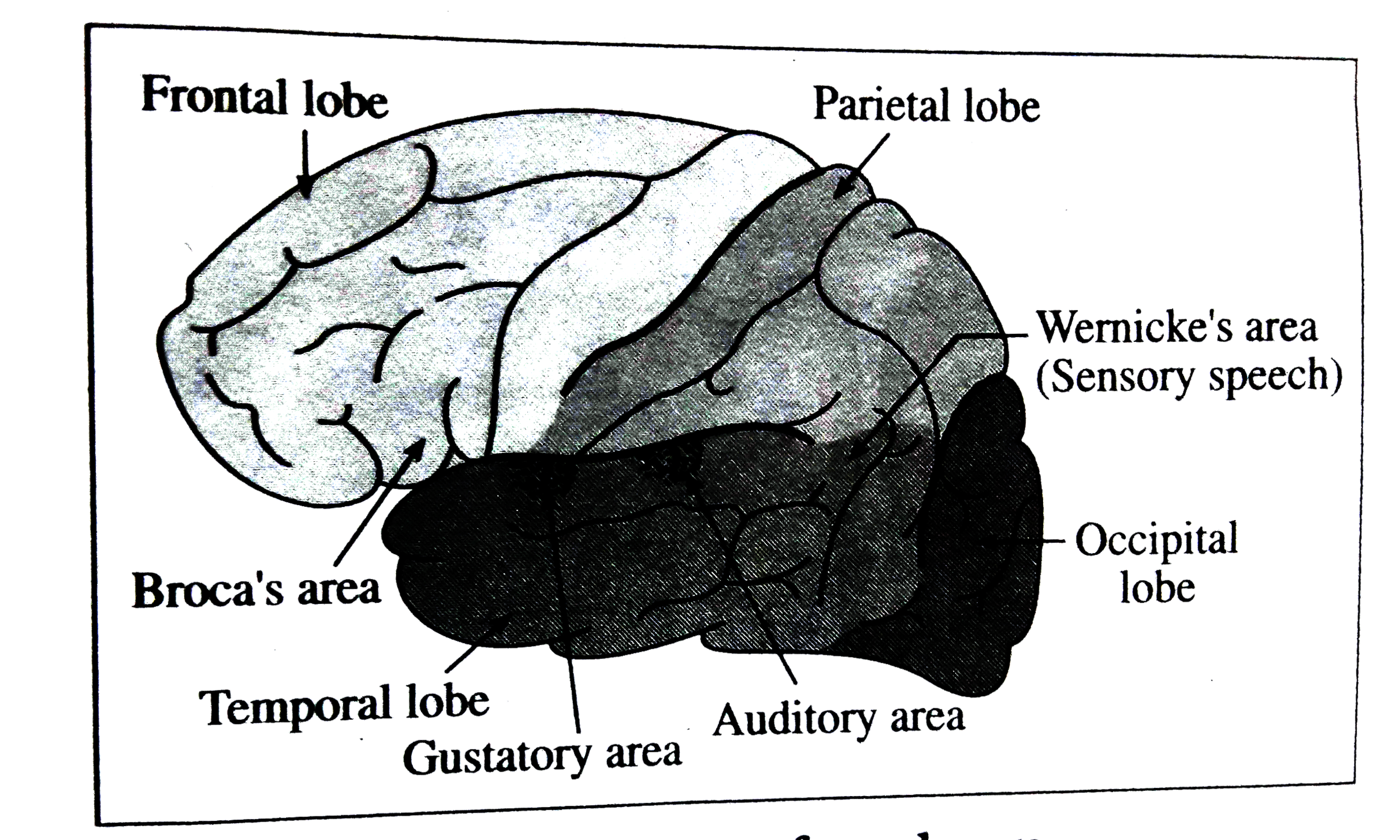 (4) The roof of cerebrumis called pallium. Pallium is highly folded formingsulci and gyri. Sulci are depressionswhile gyri are ridges. The gyriincrease the surfacearea of cerebal cortex. (5) The ventrolateral walls of cerebrum arethickenedand are called corporastriata. (6) The cerebral cortexhas three deep sulci, the central , lateraland parieto-oocipital. (7) These sulci dividethe cerebral hemisphere into four lobes. These are frontal, partietal, occipital and temporal lobes. (8) The central sulcus separates frontaland parietal lobes. the lateral sulcusseparatesparietaland temporal lobes and the parieto-occipital sulcusseparatesparietaland occipital lobe. (9) There are three functionalareas in cerebral cortex. viz., sensory,associationand motor area. Sensoryarea analyzesthe sensoryinputs. Association area processesthe information .Motorarea sendsthe motor outputs. 2. Functional areasof cerebrum are : (1) General motor area and general sensory area. (2) Association area (3) Broca's area (4) Sensory speech areaor Wernick's area. The functionsgiven below are associatedwith these areas . (6) Sensory visual area (7) AUDITORY area. 3. Functions of cerebrum : (1) The cerebrum CONTROLS the voluntary activities. (2) The cerebrumperceives various sensorystimuli receivedthroughvision. taste , smell , sound , touch, speech , etc. (3) It isthe centre of memory, willpower , intelligence resoning and learning. (4) The cerebrumis the centre for emotions, thoughtsand fellings, pain , plessure, fear, fatigue,pressure,temperature , etc. (5) It is also the centre for micturition, defecation , weeping , laughing etc. |
|
| 18064. |
Question : Describe the structure of ATP. |
|
Answer» Solution :STRUCTURE of ATP: 1. ATP is a triphosphate ester of ADENOSINE ribonucleoside. 2. It is made up of three chemical constitutents viz., a nitro-genous base purine known as adenine, apentose sugar RIBOSE and three phosphate groups. 3. To the adenosine three phosphate groups are attached in the following three phosphate groups. 3. To the adenosine three phosphate groups are attached in the following three ways: (i) Adenosine `+` Phosphate `=` Adenosine monophosphate (AMP) (ii) Adenosine monophosphate `+` Phosphate `=` Adenosine diphosphate (ADP) (iii) ADenosine diphosphate `+` Phosphate `=` Adenosine triphos-phate (ATP) 4. In an ATP molecule, two terminal phosphate groups are linked to high ENERGY bonds. 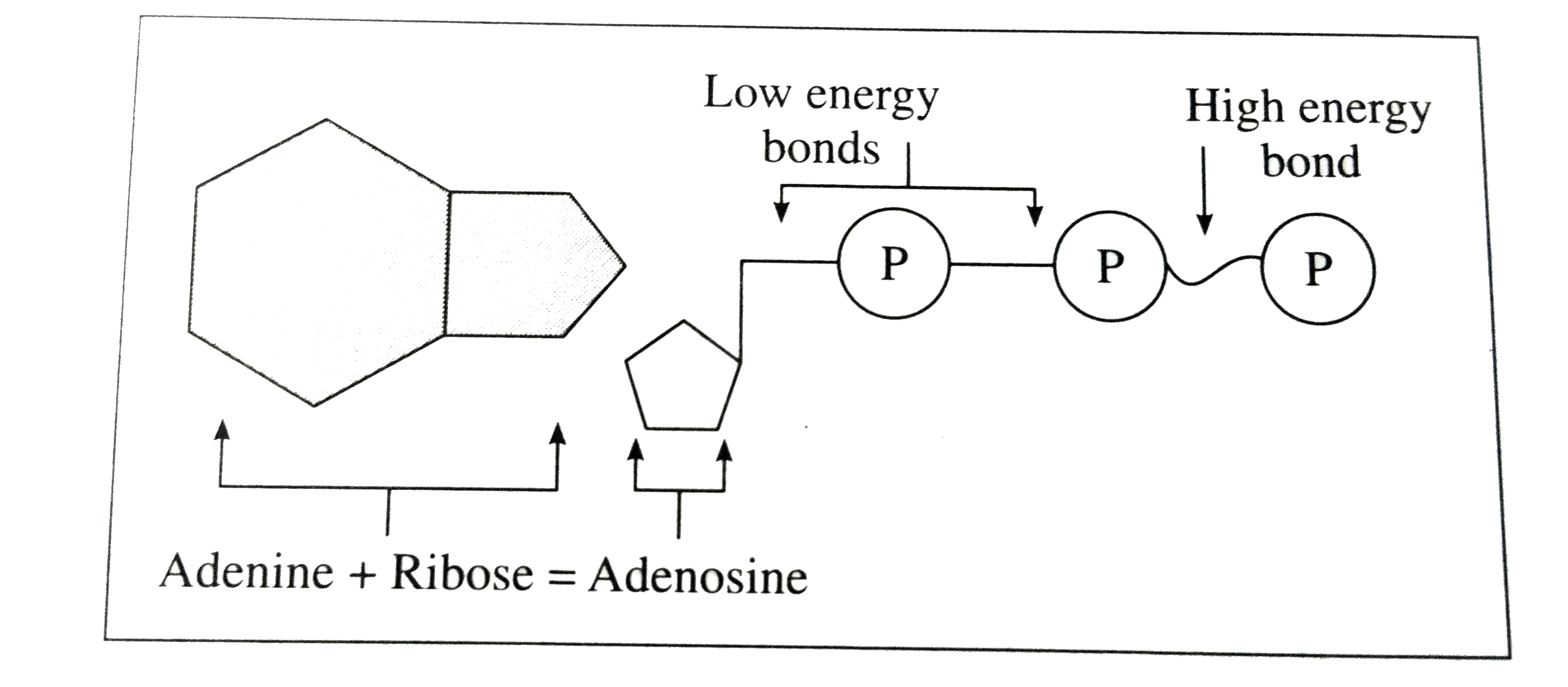
|
|
| 18065. |
Question : Describe the structure of antibody. |
Answer» Solution :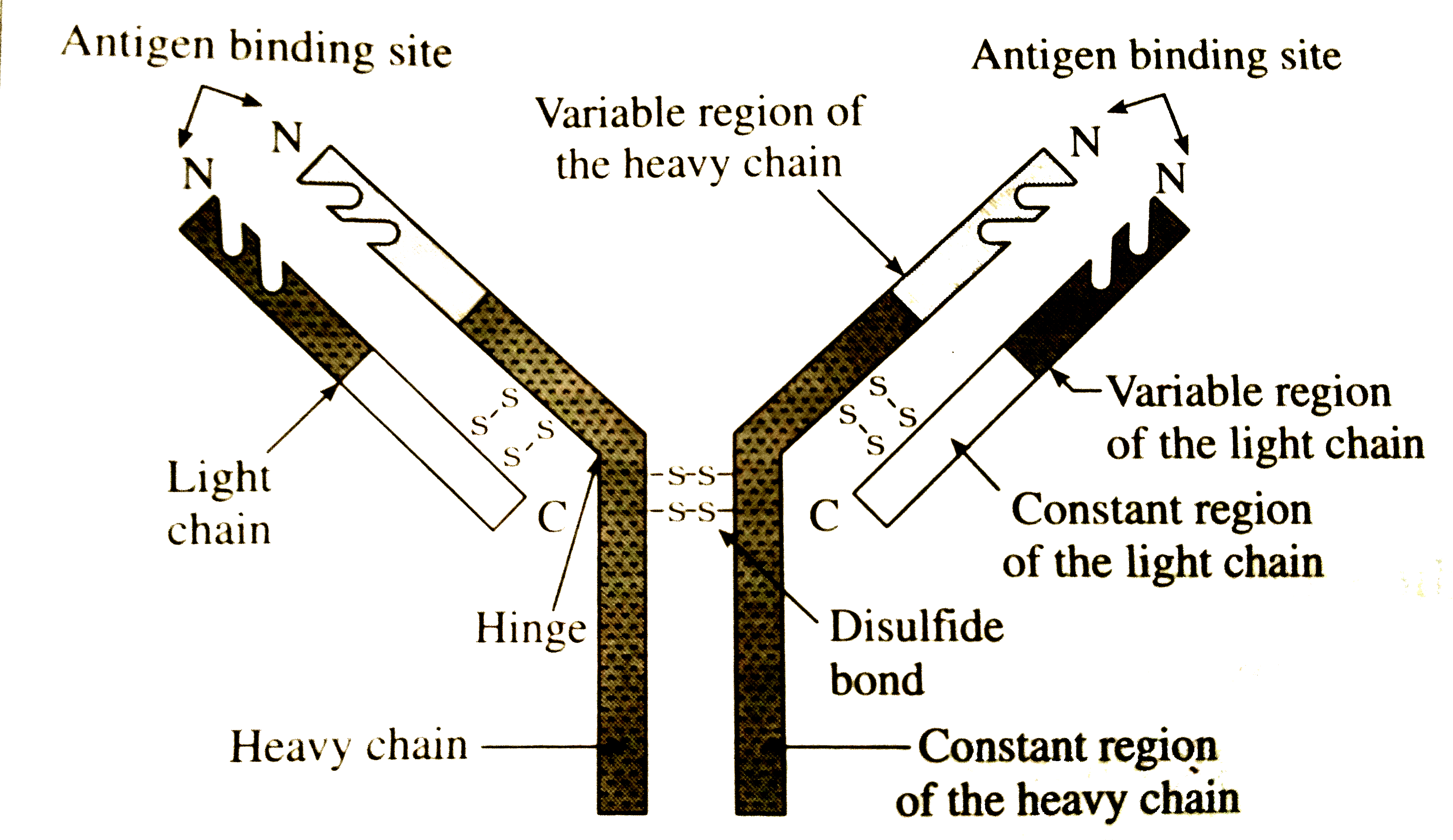 (1) Antibodies are highly specific to specific antigens. They are glycoprotein called immunoglobulins (Igs). (2) They are produced by plasma cells. Plasma cells are in turn fonned by B-lyinphocytes. (3) About 2000 molecules of antibodies are formed per second by the plasma cells. (4) Antibody is a 'Y'-shaped molecule. It has of FOUR polypeptide chains, two heavy or H chains and two light or L chains. (5) Disulfide bonds (- s-s-) hold the polypeptide chains together to form a 'Y'-shaped structure. (6) The region holding arms and STEM of antibody is termed as hinge. Each chain of the antibody has two distinct regions, the VARIABLE region and the constant region. (7) Variable regions have a paratope which is an antigen-binding site. This part of antibody recognizes and binds to the specific antigen forming an antigen-antibody complex. (8) Antibodies are called bivalent as they CARRY two antigen binding sites. |
|
| 18066. |
Question : Describe the structure of anatropous ovule with labelled diagram. |
Answer» Solution : The ovule is a SMALL structure attached to the placenta by means of a STALK called Funicle. The body of the ovule fuses with funicle in the region called hilum. The ovule has one or two PROTECTIVE envelopes called integuments. These covers the ovule EXCEPT at the tip where a small opening called micropyle. The chalaza is present opposite to the micropylar end representing the basal part of the ovule. The integuments enclose a mass of cells with reserved food called nucellus. Nucellus encloses the embryosac or FEMALE gametophyte. |
|
| 18067. |
Question : Describe the structure of a typical embryo sac found in flowering plants . Why is it generally referred to as monosporic ? |
| Answer» Solution :The process of development of a gametophyte or embryo sac from a megaspore is called megagametogenesis. The nucleus of megaspore undergoes three successive mitotic divisions forming high haploid NUCLEI. The megaspore enlarges into an oval SHAPED STRUCTURE called embryosac . The polar nuclei MAY fuse to FORM a secondary nucleus . It is a monosporic type of development and embryo sac is termed monosporic . | |
| 18068. |
Question : Describe the structure of a sperm. |
|
Answer» Solution :It is a microscopic structure composed of head, neck, a middle piece and a tall. A plasma membrane envelops the whole body of the sperm. The sperm head CONTAINS an ELONGATED haploid nucleus, the anterior portion of which is convered by a cap-like structure acrosome. The acrosome is filled with enzymes (Hyaluronidase etc) that help FERTILIZATION of the ovule. The middle pieces of sperm possesses numerous mitochondria which produce energy for the movement of tail that facilitate sperm motility essential for fertilization. The human male ejaculates about 200 to 300 million sperms during coitus of which for NORMAL fertility atleast 60% sperms must have normal shape and size and for at LEAST 40% of them must show vigorous motility. 
|
|
| 18069. |
Question : Describe the structure of a dicot seed . |
Answer» Solution :Structure of a Cicer seed as an example for Dicot seed The mature seeds are attached to the fruit wall by a stalk called funiculus. The funiculus disappears leaving a scar called hilum. Below the hilum a small pore called micropyleis present . If faciitates entry of oxygen and water into the seeds during germination . Each seed has a THICK outer covering called seed coat . The seed coat is developed from integuments of the ovule . The outer coat is called testa and is hard whereas the inner coat is thin , membranous and is called tegmen. 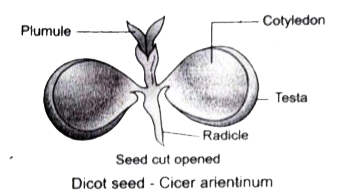 In Pea plant hte tegmen and testa are fused TWO cotyledons laterally attached to the embryonic axis are present . It stores the food materials in pea whereas in other seeds like castor the endosperm CONTAINS reserve food and the cotyledons are thin. The portion of embryonal axis projecting beyond the cotyledons is called radical or embryonic root. The other end of the axis called embryonic shoot is the plumule . Embryonal axis above the level of cotyledon is called epicotyl whereas the cylindrical region between the level of cotyledon is called HYPOCOTYL . The epicotyl terminates in plumule whereas the hypocotyl ENDS in radical. |
|
| 18070. |
Question : Describe the steps of PCR technique. |
Answer» Solution :There are THREE steps of PCR technique, viz. HEAT denatura- tion, annealing and polymerization. These steps are described in the following lines :  (1) Heat DENATURATION : In heat denaturation, the DNA is heated at `91^(@)C`. Owing to heating, the hydrogen bonds in the DNA molecule are broken. This results in the formation of ss DNA. (2) Annealing: During annealing or DNA melting ss DNA is paired with primers. The primers are designed as PER the requirements. This step is carried out at `55^(@)C`. (3) Polymerization: In this step, the temperature is RAISED to `72^(@)C`. The taq polymerase is added. This helps in adding dNTPs behind the primer on the ss DNA. |
|
| 18071. |
Question : Describe the steps of PCR technique |
|
Answer» Solution :PCR `rarr` Polymerase chain reaction includes the three steps and they are : (a) Heat denaturation : Heating of DNA at about `91^(@)C` The heating breaks the hydrogen bonds to MAKE single strand (SS) DNA. The DNA molecule with more G-C pairs, need higher temperature. (b) ANNEALING : Pairing of primers to the single strand (SS) DNA segment. It requires temperature at about `55^(@)C`. (c ) POLYMERISATION : Temperature is RAISED to `72^(@)C`. The Tag polymerase adds dNTP's behind the primer on the single strand (SS) DNA. 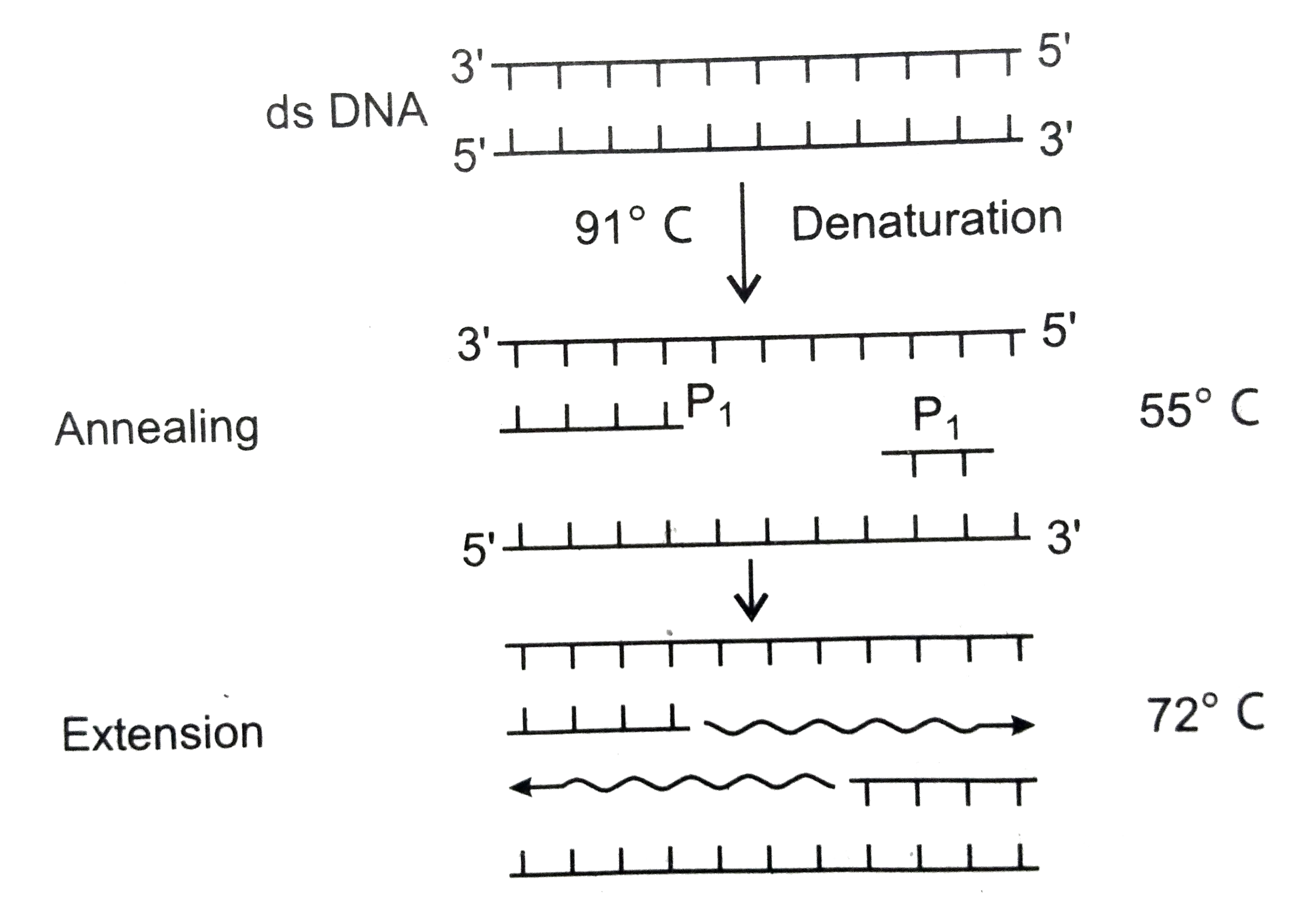
|
|
| 18072. |
Question : What are the stepinvolved in recombinant DNA rechnology ? |
|
Answer» Solution :The steps involved in recombinant DNA technology are : `**` Isolation of a DNA fragment containing a gene of interest that needs to be cloned This is CALLED an insert. `**` Generation of recombinant DNA (RDNA) molecule by inserting of the DNA fragment into a carrier molecule called a vector that can self - replicate WITHIN the host cell. `**` Selection of the transformed host cells that id carrying the rDNA and allowing them to multiply thereby multiplying the rDNA molecule. `**` The entire process thus generates either a large amount of rDNA or a large amount of protein expressed by the insert. `**` Where vectors are not involved the desired gene is multiplied by PCR technique. The MULTIPLE copies are injected into the host cell protoplast or it is shot into the host cell protoplast by short GUN method. 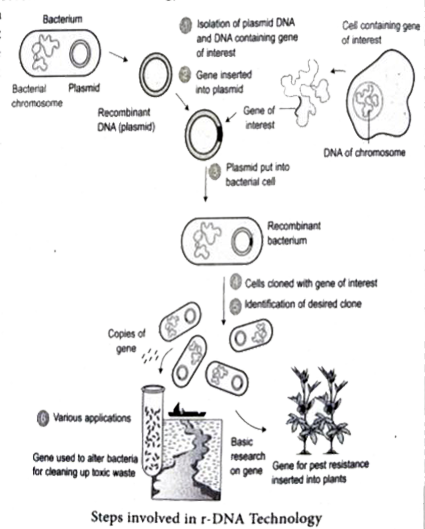
|
|
| 18073. |
Question : Describe the stages of Sewage treatment process |
Answer» Solution :Sewage treatment is USUALLY performed in the following three stages Primary treatment : Primary treatment involves the physical removal ofsolid and particulate organic and inorganic materials from the sewage through filtration and sedimentation Floating debris is removed by sequential filtration Then the grit (soil and small pebbles) are removed by sedimentation .All solids that settle form the primary sludge and the supernatant forms the efflient . The efflient from the primary settling tank is taken for secondary treatment. Secondary treatment or biological treatment : The primary effluent is passed into large aeration tanks whereit is constantly agitated mechanically andair is punped into it This allows vigorous growth of useful aerobic microbes into floc (masses of bacteria associated with fungalfilaments to form mesh like structures . While growing , these microbes consume the major part of the organic matter in the effluent . This significantly reduces the BOD (BIochemicaloxygen demand or Biolgical oxygen demand ) . BOD refers to the amount of the oxygen that would be consumed if all the organic matter in ONE litre ofwater were oxidized by bacteria . The sewage water is treated till the BOD is reduced . The greater the BOD of the waste water more is itspolluting potential Once the BOD of sewage water is reduced significantly , the effluent is then passed into a settling tank where the BACTERIAL flocs are allowed to sediment . This sediment is called activated sludge A small part of activated sludge is pumped backinto the aeration tank to serve as the inoculum . The remaining major part of the sludge is pumped into large tanks called anaerobic sludge digesters Here , the bacteria which grow anaerobically DIGEST the bacteria and the fungi in the sludge During this digestion bacteria produce a mixture of gases such as methane hydrogen sulphide and `CO_(2)` These gases form biogas and can be used as a source of energy . Tertiary treatment : Tertiary treatment is the final process that improves the quality of the waste water before it is reused recycled or released into natural water bodies . This treatment removes the remaining inorganic compounds and substances , such as nitrogen and phosphorus. UV is an ideal disinfectant for wastewater since it does not alter the water quality - except for inactivating microorganisms UV is a chemicalfree process that can completely replace the existing chlorination system and also inactivates chlorine resistant microorganisms like Cryptosporidium and GIARDIA. |
|
| 18074. |
Question : Explain the process of spermatogenesis with diagram. |
Answer» SOLUTION :Spermatogenesis is the sequence of eventsSpermatogenesis in the seminiferous tubules of the testes that produce the male gametes, the sperms. During development, the primordial germ cells migrate into the testes and becomeimmature germ cells called sperm mothercells or spermatogonia in the inner surfaces of spermatocyte the seminiferous tubules. The spermatogoniabegin to undergo mitotic division at puberty and continue throughout life. In the firststage of spermatogenesis, the spermatogonia migrate among sertoli cells towards the central lumen of the seminiferous tubule and become modified and enlarged to formprimary spermatocytes which are diploid with23 pairs i.e., 46 chromosomes. Some of the primary spermatocytes undergo first meioticdivision to form two secondary spermatocytes which are haploid with 23 chromosomes each. The secondary spermatocytes undergo second meiotic division to produce four haploid spermatids. The spermatids are transformed into maturepermatozoa (sperms) by the process called SPERMIOGENESIS. Sperms are finally released into the cavity of seminiferous tubules by a process called spermiation. 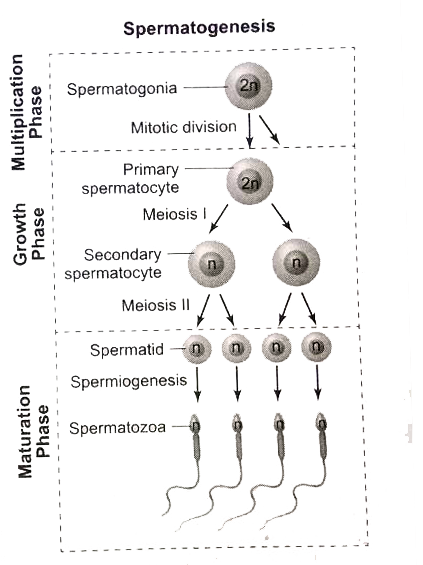 The whole process of spermatogenesis takes about 64 days. At any given time, different regions of the seminiferous tubules contain spermatocytes in different stages of development. The sperm production remains nearly constant at a rate of about 200 million sperms PER day. Spermatogenesis starts at the age of puberty and is initiated due to the increase in the release of Gonadotropin Releasing Hormone (GnRH) by the hypothalamus. GnRH acts on the anterior pituitary gland and stimulates the secretion of two gonadotropins namely Follicle Stimulating Hormone (FSH) and Lutenizing Hormone (LH). FSH stimulates testicular growth and enhances the production of Androgen Binding Protein (ABP) by the sertoli cells and helps in the process of spermiogenesis. LH acts on the Leydig cells and stimulates the synthesis of testosterone which in turn stimulates the process of spermatogenesis. |
|
| 18075. |
Question : Describe the situation in which independent assortment of genes results in 50% recombination. |
|
Answer» SOLUTION :Independent assortment of genes LEADING to 50% recombinations are due to: Homologous chromosomes SEPARATE RANDOMLY due to meiosis. Due to crossing over between homologous CHROMATIDS. During the process of crossing over two chromosomes are involved thus recombinants are not more than 50%. |
|
| 18076. |
Question : Describe the role of PCR in clinical field. |
|
Answer» Solution :PCR In Clinical Diagnosis: The specificity and sensitivity of PCR is useful for the diagnosis of inherited disorders (genetic diseases), viral diseases, bacterial diseases, etc., The diagnosis and treatment ofaparticular disease oftenrequires identifying a particular pathogen. Traditional methods of identification involve CULTURING these organisms trom clinical specimens and performing metabolic and other tests to IDENTIFY them. The CONCEPT behind PCR based diagnosis of infectious diseases is simple - if the pathogen ispresent in a clinical specimen its DNA will be present. Its DNA has unique sequences that can be detected by PCR, often using the clinical specimen (for example, blood, stool, spinal fluid. or sputum) in the PCR mixture. PCR is also employed in the prenatal diagnosis of inherited diseases by using chorionic villi samples or cells from amniocentesis. Diseases like sickle cell anemia, B-thalassemia and phenylketonuria can be detected by PCR in these samples. cDNA from PCR is a valuable tool for diagnosis and monitoring retroviral intections eg. Tuberculosis by Mycobacterium tuberculosis Several virally induced cancers, like cervical cancer caused by Papilloma virus can be detected by PCR. Sex of HUMAN beings and live STOCKS, embryos fertilized invitro can be determined by PCR by using primers and DNA probes specific for sex chromosomes. PCR technique is also used to detect sexlinked disorders in fertilized embryos. |
|
| 18077. |
Question : Describe the role of microbes in Sewage treatment plant. |
|
Answer» Solution :After the primary TREATMENT in the plant effluent is taken for secondary treatinent biological treatment effluent is constantly agitated mechanically, airpumped into it. It allows Vigorous growth of aerobic microbes into flocs. Microbes use `O_(2)` to reduce organic matter. To reduce BOD, effluent passed into SETTING tank where bacterial flocs allowed to sediment which is called activated sludge. Small part of activated sludge pumped back into AERATION tank to serve as inoculums and the remaining part is pumped into large tanks called as anaerobic sludge digester. Other kinds of anaerobically grown bacteria DIGEST the bacteria and the fungi in sludge, Bacteria produce mixture of gases. METHANE, hydrogen sulphide and carbon dioxide. |
|
| 18078. |
Question : Describe the role of microbes as biofertilizers. |
|
Answer» Solution :Bacteria, fungi and cyanobactria are main source of biofertilizers. Because they helps to enrich the soil nutrients quality. Rhizobium is a symbiotic bacteria present in root nodules in Leguminous plants and fix atmospheric nitrogen into organic form which is used by the plant as nutrient. Azospirillum and Azotobacter are free living soil bacteria, which enrich nitrogen content of the soil. Mycorrhiza is the symbiotic association of fungi with roots of higher plants. MANY members of the GENUS Glomus forms mycorrhiza. They absorbs phosphorns from the soil and pass it to the plants. Show resistant to root borne pathogens. Increase TOLERANCE to salinity and draught Cyanobacteria like Anabaena, Nostoc, oscillatoria ETC. fix atmospheric nitrogen and enriches the fertility of soil and also ADD organic matter to the soil. |
|
| 18079. |
Question : Describe the role of CaCl_(2) in the preparation of competent cells. |
| Answer» Solution :`CaCl_(2)` is known to increase the efficiency of DNA uptake to produce transformed bacterial cells. The DIVALENT `Ca^(2+)` ions supposedly create transient PORES on the bacterial cell wall by which the entry of FOREIGN DNA is FACILITATED into the bacterial cells. | |
| 18080. |
Question : Describe the role of Agrobacterium tumefaciens in transforming a plant cell. |
| Answer» Solution :Agrobacterium tumefaciens, a pathogen of several DICOT plants is able to deliever a piece of DNA to transform normal plant cells into a tumor and direct these cells to produce the chemicals required by the pathogen. Agrobacterium tuma faciens contains a plasmid called Ti-plasmid. This has a T-DNA region flanked by left border and right border sequence. The T-DNA gets transferred and integrates with the host plant DNA. This property of Ti-plasmid has been exploited for CLONING of gene of interest and stably integrating them in the plant genes. Therefore, by using Ti-plasmid or its derivatives, recombinant plant cells with desired genes of interest stably INTEGRATED in the plant genome has been successfully produced. Agrobacterium tumefaciens transfers its genes without human efforts and so is also called as natural GENETIC engineer of plants. | |
| 18081. |
Question : Describe the regeneration process noticed in living organism . |
| Answer» Solution :Regeneration is regrowth in the injured region. Regeneration was first studied in Hydra by ABRAHAM Trembley in 1740. Regeneration is two types, morphallaxis and EPIMORPHOSIS. In morphallaxis the whole body grows from a small fragment e.g. Hydra and Planaria. When Hydra is accidentally cut into several pieces, each piece can regenerate the lost parts and develop into a whole new individual. The parts usually retain their original polarity, with oralends, by developing tentacles and aboral ends, by producing basal discs. Epimorphosis is the replacement of lost body parts. It is of two types, namely REPARATIVE and restorative regeneration. In reparative regeneration, only certain damaged TISSUE can be regenerated, whereas in restorative regeneration severed body parts can develop. e.g. star fish, tail of WALL lizard. | |
| 18082. |
Question : Describe the process transcription in Eukaryotes. |
|
Answer» Solution :Transcription of Eukaryotes : In eukaryotes, there are two additional complexities : (i) There are at least three RNA polymerases in the nucleus (in addition to the RNA polymerase found in the organelles). There is a clear cut division of labour. The RNA polymerase-I transcribes rRNAs (28S, 185 and 5.8S) whereas the RNA polymerase II is responsible for transcription of TRNA, 5 s RNA and an RNAs (SMALL nuclear RNAs). The RNA polymerase-Il transcribes precursor of mRNA, the heterogenous nuclear RNA (hn RNA). (ii) The second COMPLEXITY is that the primary TRANSCRIPTS contain both the exons and the introns and are non-functional. Hence, it is subjected to a process called splicing where the introns are removed and exons are joined in a defined order. hnRNA undergoes additional processing called as capping and tailing. In capping an unusual nucleotide (methyl guanosine triphosphate) is added to the 5. end of hnRNA. In tailing, adenylate residues (200-300) are added at 3-end in a template independent manner. It is the fully processed hnRNA now called mRNA, that is transported out of the nucleus for translation.  Importance : The split-gene arrangements REPRESENT probably an ancient feature of the genome. The presence of introns is reminiscent of antiquity and the process of splicing represent the dominance of RNA - world. |
|
| 18083. |
Question : Describe the process of ultrafiltration that takes place in nephron. |
|
Answer» Solution :(I) Ultrafiltration: 1. This is a physical process taking place in the Malpighian body. The diameter of afferent renal arteriole is larger then the diameter of efferent renal arteriole and HENCE there is hydrostatic PRESSURE developed on the contentsinside the blood vessels in the glomerulus. This pressure is called effective filtration pressure or EFP. 2. 99% of the filtrate is reabsorbed and only 1 to1.5 litres of urine is formed per day. 3. Outer parietal layer and INNER visceral layesr of Bownman's capsule enclose a space called urinary space. The inner visceral layer contains podocytes which are specialized cells. 4. Due to semipermeable glomerular endothelial membrane, low molecular WEIGHT substances ALONG with water and other substancees are pulled out of the blood and enter into urinary space. This filtrate is blood plasma except proteins and blood corpuscles. |
|
| 18084. |
Question : Describe the process of translation. |
|
Answer» Solution :Translation refers to the process of polymerisation of amino acids to form a polypeptide. The order and SEQUENCE of amino acids are defined by the sequence of bases in the mRNA. The amino acids are joined by a bond which is known as a peptide bond. Formation of a peptide bond requires energy. Therefore, in the first phase itself amino acids are activated in the presence of ATP and linked to their cognate tRNA - a process commonly called as charging of tRNA or aminoacylation of tRNA to be more specific. If two such charged tRNAs are brought close enough the formation of peptide bond between them would be favoured energetically. The presence of a catalyst would enhance the rate of peptide bond formtion. The cellular factory responsible for synthesising proteins is the ribosome. The ribosome consists of structural RNAs and about 80 different proteins. In its inactive state, it EXISTS as two subunits, a large subunit and a small subunit. When the small subunit encounters an mRNA, the process of translation of the mRNA to protein BEGINS. There are two sites in the large subunit, for subsequent amino acids to bind to and thus be close enough to each other for the formation of a peptide bond. The ribosome also acts as a catalyst (23S rRNA in bacteria is the enzyme ribozyme) for the formation of peptide bond. A translational unit in mRNA is the sequence of RNA that is FLANKED by the start codon (AUG) and the stop codon and codes for a polypeptide. An mRNA also has some additional sequences that are not translated and are referred as untranslated regions. (UTR). The UTRs are present at both 5.-end (before start codon) and at 3.-end (after stop codon). They are required for efficient translation process. For initiation, the ribosome binds to the mRNA at the start codon (AUG) that is recognised only by the INITIATOR tRNA. The ribosome proceeds to the elongation phase of protein synthesis. During this stage, complexes composed of an amino acids linked to tRNA, sequentially bind to the appropriate codon in mRNA by forming complementary base pairs with the tRNA anticodon. The ribosome moves from codon to codon along the mRNA.  Amino acids are added one by one, translated into polypeptide sequences dictated by DNA and represented by mRNA. At the end, a release factor binds to the stop codon, terminating translation and releasing the complete polypeptide from the ribosome. |
|
| 18085. |
Question : Describe the process of translation of mRNA. |
|
Answer» Solution :Process of Translation Translation is a process of polymerisation of AMINOACIDS to form a polypeptide (Proteins) from the CODONS of mRNA.  1. Activation or charging of amino acid: Amino acids before they attach to t RNA should be activated by using ATP molecules. Amino acid `+` ATP - Activated amino acid. Activated amino acid will be picked up by at RNA MOLECULE and form amino acyl tRNA. This process is called charging of amino acid. 2. Chain initiation: 1. The formation of polypeptide chain is initiated by the initiator codon AUG. 2. First mRNA binds to smaller subunit of ribosome ie (30s) and later on larger subunit joins. 3. Larger sub unit (50s) has a site (Aminoacyl site], P site peptidyl site enzyme peptidyl transfer are and an Esite or exit site. 4. Chain ELONGATION: Ribosomal subunit shirts from one codon to another codon on the mRNA strand. tRNA CARRYING an amino acid shifts from A site to P site. At P site of 5os subunit peptide bond formation takes place between 2 amino acids and it is catalyzed by peptidyl transfer enzyme and elongation factos `EF_(1), EF_(2), EF_(3)`. Chain keeps elongating. 5. Chain termination: Codons Present on m RNA strand are translated by ribosomes continuously to form a long polypeptide chain until the ribosomes reach the terminator codons (UAA, UAG, UGA). |
|
| 18086. |
Question : Describethe process of transcription in protein synthesis. |
|
Answer» Solution :(1) Transcription is the process in whichall the TYPES of RNA moleculesare formed. It is the friststep in the protein synthesis . In this,m -RNAstrand is formed fromDNAtemplate. (2)Initiatingthe process of transcription requiredthe presence of an enzyme called DNAdependentRNApolymerase. Genticinformation fromDNAis copiedinto m-RNAduringthe step, (3) A transcription unithas a promoter,the structuralgeneand a terminator. Thistranscripitonunithelpsin thetranscription process. The DNAstrandwhich is used for thesynthesisof RNA is calledtemplatestrand or antisencestrand. Thisis oriented in ` 3' to 5'`direction . The otherstrandwhich is no involvedin RNAsynthesisis calledcodingstrandor sense strand . THS strandhas theorientation` 5' to 3'` . A smallDNAsequence is usedas a binding site for RNApolymerase.thisregionis calledpromoter. Promoteris presenttowards 5 end.Towardsthe 3' end there is anothersmall DNAsequence called terminator.5' endis calledupstreamwhilethe 3' endis called downstream. (4)structural gene is generallymonocistronicin eukaryotes and polycistronic in prokaryotes. This gene getstranscribed. In eukaryotes. the geneshaveintronsand exons. In theexons, DNAsequences are expressedin the mature or processedRNA. Duringtranscription , the enzyme RNApolymerase bindsto the promoter site.it initiates the process . Dueto thistwostrandsof DNAseparate . ComplementaryRNA nucleotides arejoined to form the m-RNAstrand. Thisprocess is calledelongation . (5)A smallpartof RNAremainsattached to theenzyme RNA polymerase.This partreaches the terminator region and then bothenzyme and NEWLY synthesized m-RNAfalloff.Thisis called terminationof the transcription. 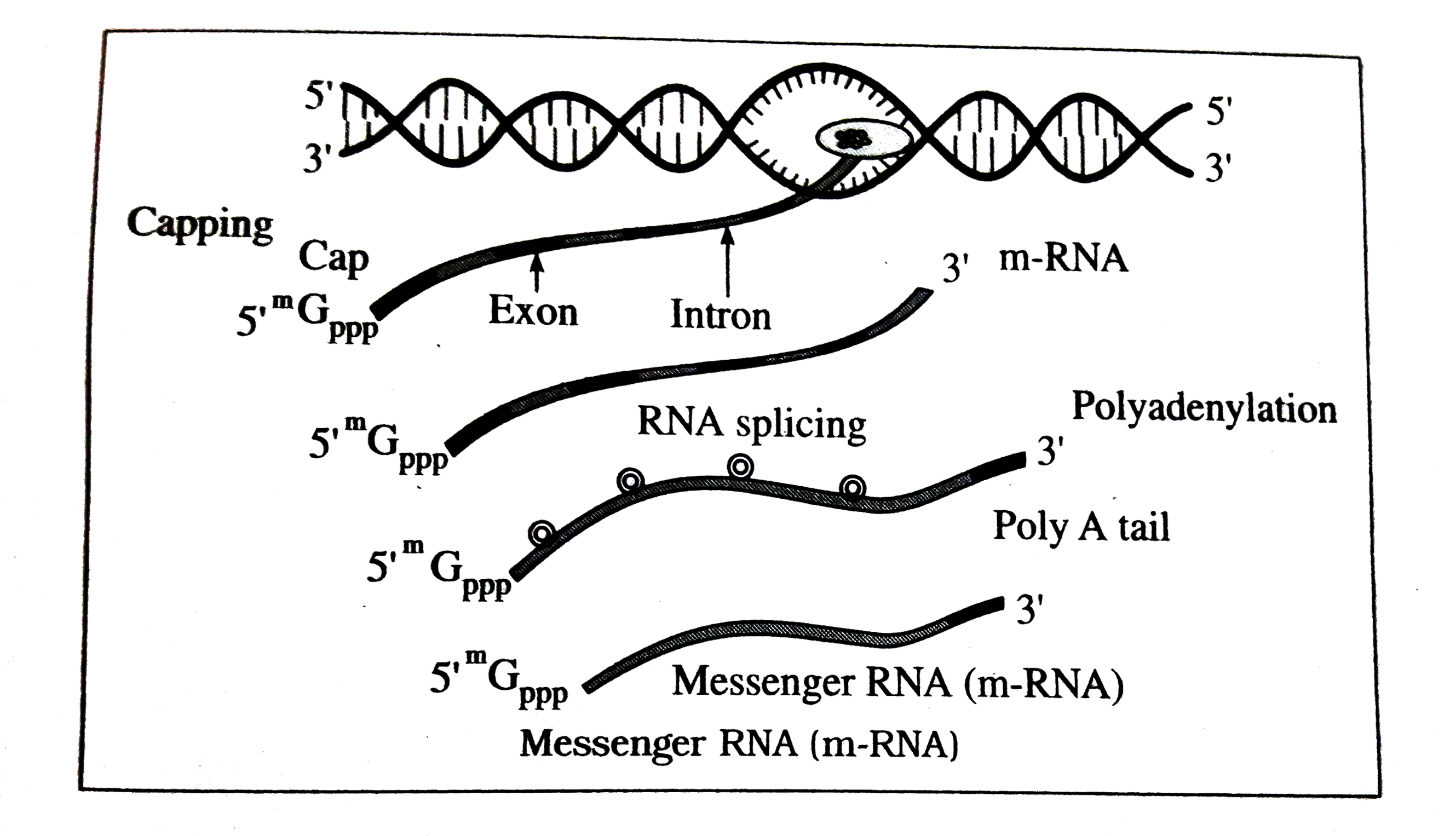 (6) Forthe process of transcription. initiation fator (` gamma` sigma) and temination factor(`rho` rho) are ESSENTIAL . In prokaryotesfurtherprocessingof RNAdoes notnot takeplacebut in eukaryotes , there is anelaborate process of RNAprocessing . Thereare three types of RNApolymeraseenzymesfor this purpoe. These are RNApolymerase I , II and III. (7) (i) r-RNAis formedis formedby RNApolymerase I. (ii) hn-RNA (het- eroncuclear RNA)is formedby RNApolymerase II and (iii) t-RNAand sn-RNA (small nuclear) are formedby RNApolymerase III. (8)The RNAformedby transcriptioon is non functionalin eukaryotes. It undergoesfurther processing for becoming active. Thisprocess consistsof splicing, cappingand TAILING (9) Suchhn-RNA whichundergoessplicing , cappingand tailingnow becomes m-RNA. In eukaryotic cellsthe m-RNA molecular leavesnucleusand goes toribosomes to carryout the further process of protein synthesis. |
|
| 18087. |
Question : Describe the process of spermatogenesis with labelled diagram. |
|
Answer» Solution :In TESTIS, the immature male germ cells produce sperms by spermatogenesis that begins at puberty. Spermatogenesis is a continuous process. It has mainly two steps : (1) Formation of spermatids and (2) SPERMIOGENESIS. (1) Formation of spermatids : The germ cells which produce sperms are called primary spermatocytes. For the formation of these primary gametes sperms it passes through 3 phases. (i) Multiplication phase : The spermatogonia present on the inside wall of seminiferous tubules multiply by mitotic division and increasein nucleus. Each spermatogonia is diploid and contains 46 chromosomes.  (ii) Growth phase : In this phase spermatoginum collects nutritive material and chromation in large amount. Each spermatogonium is also known as primary spermatocytes which take nutrition from the nutritive sertoli cells. (iii) MATURATION phase : Primary spermatocytes periodically undergo meiosis. A primary spermatocytes completes the first meiotic division leading to formation of two equal, haploid cells called secondary spermatocytes which have only 23 chromosomes each. The secondary spermatocytes undergo the second meiotic division to produce four equal, haploid spermatids. (2) Spermiogenesis : The spermatids are transformed into SPERMATOZOA by the process called spermiogenesis. After spermiogenesis SPERM heads became embedded in the sertoli cells and are finally released from the seminiferous tubules by the process called spermiation. |
|
| 18088. |
Question : Describe the process of spermatogenesis upto the formation of spermatids. Mention the fate of spermatids. |
|
Answer» Solution :Formation of haploid sperms from the diploid spermatogonial cells of the testes is called spermatogenesis. Primordial germ cells give rise to spermatogonial cells and sertoli cells. It is the spermatogonial cells that develop into the spermatozoa. Spermatogenesis involves four phases., viz.. a.Multiplication Phase b. Growth Phase c.Maturation Phase d. spermiogenesis (a) Multiplication Phase: The diploid spermatogonial cells of the seminiferous TUBULES divide repeatedly by mitosis to form more spermatogonial cells. Among them only a few will enter into growth phase and others are kept reserve. (b) Growth Phase: Spermatogonial cells obtained from multiplication phase grow in size, however they still remain diploid. These cells are now called primary spermatocytes. (c) Maturation Phase: This phase involves two successive divisions, viz., Meiosis I and Meiosis II. The meiosis I is reductional and two haploid cells are formed from each primary spermatocyte. The resultant cells of I meiotic division are called secondary spermatocytes. These secondary spermatocytes undergo meiosis II which is equational. As a result each secondary spermatocyte produces two haploid cells of equal size called spermatids. Hence, four haploid spermatids are formed during maturation phase from each diploid primary spermatocyte. (d) Spermiogenesis: Spermatids are not gametes, they are ordinary haploid cells. During spermiogenesis or spermateliosis each spermatid in association with sertoli cells become TADPOLE like, FLAGELLATED and highly motile gamete called SPERMATOZOAN orsperm. 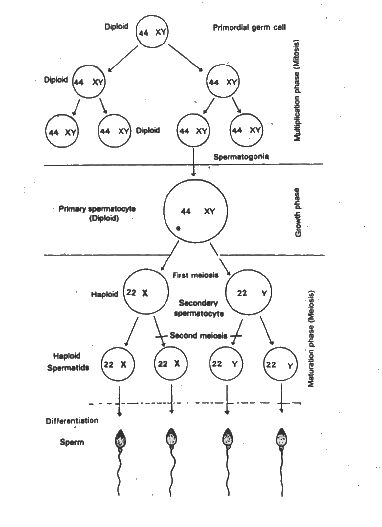
|
|
| 18089. |
Question : Describe the process of sex determination in humans. |
|
Answer» Solution :The sex determining mechanism in CASE of human is XX : XY type. = In humans out of 23 pairs of chromosomes present 22 pairs are exactly same in both males and females known as autosomes. = The `23^(rd)`PAIR of chromosome is the sex chromosome i.e. a pair of X-chromosome [XX] is present in females and males having one .X. and one .Y. chromosome [XY]. =During spermatogenesis, in case of males, two types of gametes are produced. =The 50% of total sperms produced carry-chromosomes and the rest 50% carry Y-chromosomes besides autosomes. =This condition is called male digamy. = The Y-containing sperms and X-containing sperms are called andosperms and gynosperms respectively. = Female produces only one type of ovum with an X-chromosome. =If an ovum FERTILISES with a sperm carrying X-chromosome, the zygote develops into a female (XX) and if an ovum is fertilised with sperm carrying Y-chromosome zygote thus formed will be a male (XY). = Hence the genetic make up of sperm, which fertilises the ovum determines the sex of a child. =There are 50% chances of having either a male or female in each pregnancy. = Thus it is a by CHANCE phenomenon. So women should not be BLAMED for giving birth to a girl child. 
|
|
| 18090. |
Question :Describe the process of Parturition in humans. |
| Answer» Solution :Parturition is a neuroendocrine mechanism and is started by the SIGNALS from the fully developed FETUS and the placenta, which produce the fetal ejection reflex. This CAUSES a release of oxytocin from the posterior pituitary which in turn causes even stronger UTERINE contractions. Contractions of uterine lead to the expulsion of the baby along with the placenta, and hence completes the process of parturition. | |
| 18091. |
Question : Describe the process of primary succession on bare rocks. |
|
Answer» Solution :Primary succession on rocks LICHENS ( Pioneer SPECIES they secrete acids to dissolve ROCK, helping in weathering and soil formation ) - Small Plants like bryoplhytes (they need only small amount of soil) bigger plants - stable climax forest community. (mesophytic) The climax community remains stable as long as the environment remains UNCHANGED. |
|
| 18092. |
Question : Describe the process of oogenesis. |
|
Answer» Solution :The process of formation of a mature female GAMETES is called oogenesis. Oogenesis is initiated during the embryonic development stage when a couple of million gametes mother cells are formed within each fetal ovary.  No more oogenia are formed and added after birth. Primary oocytes : These cells START division and enter into prophas-I of the meiotic division and get temporarily arrested at that stage called primary oocytes. Primary follicle : Each primary oocyte then gets surrounded by a layer of granulosa cells and is called the primary follicle. A large number of these follicles DEGENERATE during the phase from birth to puberty. Secondary follicle : The primary follicle get surrounded by more LAYERS of granulosa and a new theca and are called secondary follicles. TERTIARY follicles : The secondary follicles soon transforms into a tertiary follicle which is characterised by a fluid filled cavity called antrum. The theca layer is organised into an inner theca interna and an outer theca externa. Now, the primary oocyte within the tertiary follicle grows in size and completes its first meiotic division. It is in unequal division resulting in the formation of large haploid secondary oocyte and a tiny first polar body. The secondary oocyte retains bulk of the nutrient rich cytoplasm of the primary oocyte. The tertiary follicle further changes into the mature follicle or Graafian follicle. The secondary oocyte forms a new membrane called zona pellucida surrounding it. The Graafian follicle now ruptures to release the secondary oocytes (ovum) from the ovary by the process calledovulation. The difference between spermatogenesis and oogenesis can be seen in the following figure. 
|
|
| 18093. |
Question : Describe the process of implantation of embryo. |
Answer» Solution : The MITOTIC division starts as the zygote moves through the isthmus of the OVIDUCT called cleavage towards the uterus and forms 2, 4, 8, 16 daughter cells called blastomeres. The embryo with 8 to 16 blastomeres is called a morula. The morula continues to divide and further moves into the uterus and transforms into blastocyst. The blastomeres in the blastocyst are arranged into an outer layer called trophoblast and inner group of cells attached to trophoblast called the inner cell mass. All these changes occur in a week.s time. The creation of blastocyst located in morula is done by cells of trophoblast. Enzymes are secreted from the cells of endoderm which included some tissues and BLOOD vessels of walls of uterus and MAKES implanatation possible. The inner wall of uterus develops and partially surrounds embryo. This process is called implantation. The uterine cells divide rapidly and covers the blastocyst. It is called implantation and it leads to pregnancy. |
|
| 18094. |
Question : Where the pollengrains are develop in anther during microsporogenesis? |
|
Answer» Solution :When the anther is young a group of COMPACTLY arranged homogenous cells called the sporogenous tissue occupies the CENTRE of each MICROSPORANGIUM. As the anther develops, the cells of the sporogenous tissue undergo meiotic divisions to form microspore tetrade. As each cell of the sporogenous tissue is capable of giving rise to a microspore tetrad. Each one is a potential pollen or microspore mother cell. The process of formation of microspores from a pollen mother cell through MEIOSIS is called microsporogenesis. The microspores as they are formed, are arranged in a cluster of four cells is the microspore tetrad. As the anthers mature and dehydrate the microspores dissociate adn dehydrate the microspores dissociate from each other the develop into pollen grains. Inside each microsporangium several thousands of microspores or pollen grains are formed that are released with the dehiscence of anther 
|
|
| 18095. |
Question : Describe the process of DNA replication with the help of a diagram. |
|
Answer» Solution :The semi-conservative method of DNA replication was proposed by watson and crick. It is EXPERIMENTALLY proved by Meselson and stahil. 1. Replication always begins at origin of replication site (ORI site). The two strands of DNA starts unwinding and gets seperated with the HELP of unwindase enzyme or Helicase. The two separated strands look like .Y. shape and this is CALLED replication fork. The separated DNA strands act as template for the synthesis of new strand. 2. RNA primer is a short segment of RNA synthesized on DNA template with the enzyme DNA polymerase Ill initially in 3. to 5. direction. 3. This is followed by the formation of new DNA strand by DNA polymerase enzyme. Synthesis of new complementary strand takes PLACE on both the templates in opposite direction. 4. During replication one daughter strand is formed continuously called leading strand, whereas the other strand is formed in fragments, called okazaki fragment. These fragments are then joined to form the LAGGING strand by the enzyme ligase. 5. The semi conservative replication is the method where one strand of parent molecule is conserved in the daughter molecule of DNA and the other is newly synthesized. 
|
|
| 18096. |
Question : Describe the process of decomposition of detritus under the following heads : Fragmentational leaching, catabolism, humification and mineralization. |
|
Answer» Solution :Decomposition is the process in which the complex organic MATTER is broken down into simpler organic substances and ultimately into INORGANIC compounds. Steps of Decomposition. (i) FRAGMENTATION : It is the process of breaking of the detritus into smaller PARTICLES by detritivores like EARTHWORM. (ii) Leaching : It is the process in which water soluble inorganic substances run down mto soil horizon and get precipitated as unavailable salts. (iii) Catabolism: The enzymatic conversion of the detritus into simple organic compounds and then into inorganic compounds is called catabolism. (iv) Humification : Humification during decomposition leads to the accumulation of a dark cloured amorphous substance called humus. (v) Mineralisation : It is the process in which the humus is degraded by certain microbes and the inorganic nutrients are relased. The products of decomposition are simple organic moleculers and inorganic compounds. |
|
| 18097. |
Question : Describe the process of blood clotting. |
|
Answer» Solution :Clotting of blood : (1) When the blood vessel is intact, blood does not clot due to the presence of active anticoagulants like heparin and antithrombin. (2) But when there is an injury causing rupture of a blood vessel, bleeding starts. (3) This bleeding is stopped by the process of blood clotting during which liquid blood is converted into semisolid jelly. (4) The events occurring during blood clotting are as follows : (i) Release of THROMBOPLASTIN from thrombocytes and injured tissue. (ii) FORMATION of enzyme prothrombinase in the blood due to initiation of thromboplastin. (iii) Conversion of inactive prothrombin into active thrombin by prothrombinase in the presence of Ca ions. (iv) Conversion soluble fibrinogen into insoluble fibrin by thrombin. (V) Formation of a clot by enmeshing platelets, other blood cells and plasma in the fibrin fibres enmesh. (5) These reactions occur in 2 to 8 minutes. The refore, clotting time is said to be 2 to 8 minutes. |
|
| 18098. |
Question : Explain the process of budding in Hydra with the help of labelled diagram. |
Answer» Solution :1. Budding is the process of asexual reproduction seen inmulticellular but less evolved animals. 2. On the LATERAL side of the BODY parent HYDRA a smal bud GROWS. This bud develops into Young Hydra. 3. Young Hydra then detaches from the parent body upon reachign enough development. 4. After detachment it leads an independent life. |
|
| 18099. |
Question : Describe the procedure involved in Blue-White colony selection methods. |
|
Answer» Solution :Blue-White Colony Selection Method is a powerful method used for screening of RECOMBINANT plasmid. In this method, a reporter GENE lacZ is INSERTED in the vector. The lacZ encodes the ENZYME `beta`-galactosidase and contains several recognition SITES for restriction enzyme. `beta`-galactosidase breaks a synthetic substrates called X-gal (5-bromo-4-chloroindolyl- `beta`-Dgalacto-pyranoside) into an insoluble blue coloured product. If a foreign gene is inserted into lacZ, this gene will be inactivated. Therefore, no-blue colour will develop (white) because `beta`-galactosidase is not synthesized due to inactivation of lacZ. Therefore, the host cell containing r-DNA form white coloured colonies on the medium contain X-gal, whereas the other cells containing non-recombinant DNA will develop the blue coloured colonies. On the basis of colony colour, the recombinants can be selected. |
|
| 18100. |
Question : Technique by which Dolly was developed ___________ . |
|
Answer» Solution :Dolly was the first mammal (Sheep) clone developed by lan Wilmut and Campbell in 1997. Dolly, the TRANSGENIC clone was developed by the uclear transfer technique and the phenomenon of totipotency. Totipotency refers to the potential of a cell to develop different cells, tissues, organs and finally an organism. The mammary gland udder cells (somatic cells) from a donor sheep (ewe) were isolated and subjected to starvation for 5 days. The udder cells could not UNDERGO normal growth cycle, entered a dormant stage and became totipotent. An ovum (egg cell) was taken from another sheep (ewe) and its NUCLEUS was removed to FORM an enucleated ovum. The dormant mammary gland cell/udder cell and the enucleated ovum were fused. The outer membrane of the mammary cell was ruptured allowing the ovum to envelope the nucleus. The fused cell was implanted into another ewe which served as a surrogate mother. Five months later dolly was born. Dolly was the first animal to be cloned from a ditferentiated somatic cell taken from an adult animal WITHOUT the process of fertilization. |
|